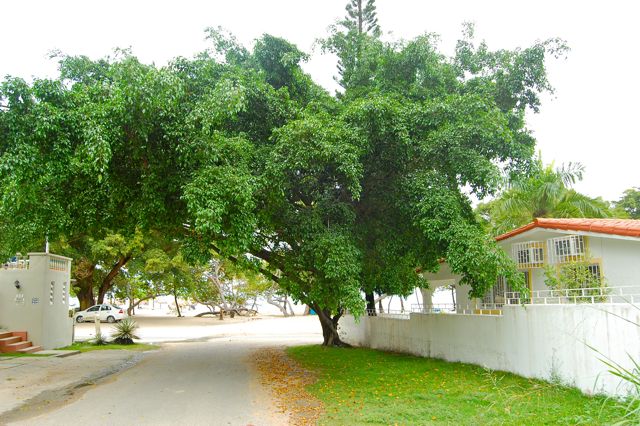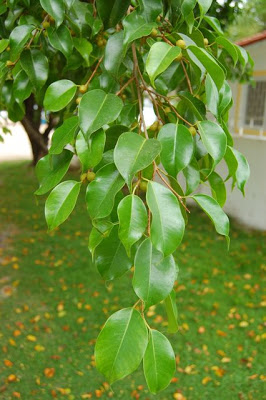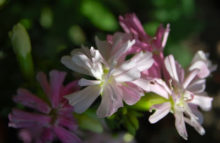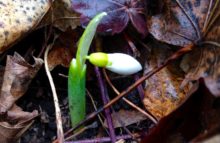Words are funny things. They come into the language, and chang
e shape and meaning over time. Most of us know what it means to call someone ruthless. Fewer would describe someone as full
of ruth. Ruth (pity and compassion) has slipped out of common usage.
In the gardening world, we call houseplants tropicals, yet even experienced Northern gardeners sometimes forget the true meaning of that word. Tropical. You know: where it’s bright, hot and humid.
Above, my friends, is a picture (from the Dominican Republ
ic) of one of the more ubiquitous indoor plants, a weeping fig or Ficus benjamina. Yes, that’s one tree stretching across the entire street. In fact, it’s duking it out for space with a Norfolk Island pine, or Araucaria heterophylla, rising behind it at my estimate to 50 or 60 feet tall.
In case you still don’t recognize the ficus from countless office atria or your local big-box houseplant section, a close-up of the leaves is shown at right; you can see the trunk from which this branch stems way in the background.
In their natural state in the tropics, the things we call “houseplants” grow to the size of trees. Not just the Ficus benjamina here, but Ficus elastica (rubber plant), Shefflera (umbrella plant), Monstera (the climber commonly though incorrectly called split-leaf philodendron), and many more.
As for most of these plants, our pal benjamina likes it tropical (hot and humid) – with an accent on humidity. Our oft-overheated Canadian homes can deliver the “hot” over winter, but humidity – the key to their successful culture – is harder to achieve. Yet, you can help it along in a couple of ways:
One: pretend you’re hosting it at some ritzy tropical resort, and give it a regular spritz of water. Evian not required.
Two: rest the pot on stones above a tray of water, so evaporation moistens the surrounding air. However, never let the pot sit with wet feet. Overwatering and poor drainage are the fastest ways to kill almost any houseplant. Let the top couple of inches of soil dry out between waterings (it should feel dry to the touch, but not so dry that the soil pulls away from the sides of the pot!), and leave a gap of air between the base of the pot and the water level in the tray
F. benjamina likes light, as you can imagine from the first picture. However, due to its need for moisture in the air, it should not get direct sun from a window during the hottest part of the day, or it will get sunburn.
It also needs consistency, so keep it out of hot or cool drafts. If you move it outdoors in summer – which it likes, if done correctly – be gradual about changes in temperature, light or air circulation. (Usually, you’ll notice this dislike of change in late summer when you bring it back indoors – and it promptly loses all its leaves.) Outdoors, you might have to water it more frequently, though still let the soil dry out between waterings, and top up that tray of water.
My last word on this tropical topic is about feeding. After letting your houseplants diet over the winter, in February or March when the sunlight begins to strengthen you can begin feeding your
houseplants. Give them a dilute meal of 1/4 strength fertilizer with every watering, and you won’t have to mark any feeding dates on your calendar.






6 comments
Great advice for caring for our 'tropical' plants! Thank you for the word thought too… so true about ruth! What a beautiful ficus tree! No wonder my old tree was trying to grow through the ceiling! Happy Spring! ;>) Carol
Thanks for an informative post and good advice on caring for tropicals. When I see these plants growing in their native habitat, I realize what a paltry environment a pot inside a house provides!
Fantastic advice and great photos. One reason I don't have houseplants is that they require me to attend to them~~at least a little! The best reason, is that the cat would eat them and then make a great big mess.
Gail
ps My grandmother's name was Ruth~I like thinking of her full of compassion.
Wow, that must be the momma fiscus of my little fiscus and everybody else's too! Must put rocks in bottom of tray…!
Good advice Helen. I gave up trying to grow most tropicals because the wood stove is really good at sucking out what little moisture is in the air. Misting plants is not on my list to do especially when my 14 year old Araucaria heterophylla is now almost as tall as me. I grow mostly cacti and succulents and other easy houseplants:)
Helen, thanks for the definition of "ruth" (no one is feckfull or reckfull either, I've noticed). Having a picture of a houseplant in its native clime is a great idea for giving us a notion of what it needs. I'm always amazed by seeing full-grown versions of my dinky houseplants.
(by the way, Melanie, I find putting a humidifier on my woodstove works wonders for my tropical houseplants, at least in my climate. I keep water topped up in an old Le Creuset casserole, and throw in cinnamon sticks or lemon oil as fancy demands. Side benefit: fewer sinus problems and sore throats.)